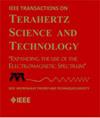太赫兹光导天线制造公差的影响
IF 3.9
2区 工程技术
Q2 ENGINEERING, ELECTRICAL & ELECTRONIC
IEEE Transactions on Terahertz Science and Technology
Pub Date : 2025-04-09
DOI:10.1109/TTHZ.2025.3558962
引用次数: 0
摘要
本文研究了受衬底芯片缺陷影响的光导天线(PCA)的辐射方向图,旨在表征制造公差。我们表明,在交叉极辐射模式上观察到的不对称性可以用来数值估计衬底芯片几何缺陷的最突出趋势。通过模拟和实验测量,定义、表征和验证了性能值(FoM),证明它对衬底不规则性的大小和位置都很敏感。重点研究了两种衬底缺陷,角度切割和偏离中心的天线间隙,并考虑了三种平面天线几何形状:偶极子、领结和Sierpinski三角形偶极子。FoM表达式中包含了与印在衬底上的平面天线几何形状相关的数值天线因子,以公平比较具有不同金属图案的pca衬底的不规则性。一个简单的实验装置,通过准直光束光栅扫描测量的交叉极辐射方向图来获得FoM的值,证明了FoM的实际意义。这些值评估了衬底芯片的制造质量,并有助于确定对PCA性能影响最大的衬底缺陷的位置和大小。本文章由计算机程序翻译,如有差异,请以英文原文为准。
On the Influence of Fabrication Tolerances in Terahertz Photoconductive Antennas
We present a study of the radiation pattern of photoconductive antennas (PCA) subject to substrate chip defects, aiming at characterizing fabrication tolerances. We show that the asymmetries observed over the crosspolar radiation patterns may be exploited to numerically estimate the most prominent trends of the substrate chip geometrical imperfections. A figure of merit (FoM) has been defined, characterized, and validated through simulations and experimental measures, proving it is sensitive to both the magnitude and location of the substrate irregularities. The study has been focused on two kinds of substrate defects, the angled dicing and the off-centered antenna gap, and it has considered three planar antenna geometries: dipole, bow-tie and Sierpinski triangle dipole. A numerical antenna factor related to the planar antenna geometry imprinted over the substrate is included in the FoM expression for fair comparison of substrate irregularities among PCAs with different metallic patterns. A simple setup for experimentally obtaining the value of the FoM through collimated beam raster scanning measure of the crosspolar radiation pattern has been proved useful to validate the practical relevance of the FoM. These values asses the substrate chip fabrication quality and help to identify the position and magnitude of the substrate defects that have the greatest impact on the PCA performance.
求助全文
通过发布文献求助,成功后即可免费获取论文全文。
去求助
来源期刊

IEEE Transactions on Terahertz Science and Technology
ENGINEERING, ELECTRICAL & ELECTRONIC-OPTICS
CiteScore
7.10
自引率
9.40%
发文量
102
期刊介绍:
IEEE Transactions on Terahertz Science and Technology focuses on original research on Terahertz theory, techniques, and applications as they relate to components, devices, circuits, and systems involving the generation, transmission, and detection of Terahertz waves.
 求助内容:
求助内容: 应助结果提醒方式:
应助结果提醒方式:


